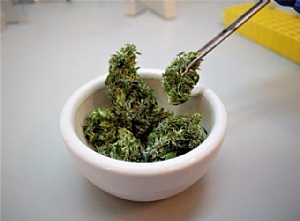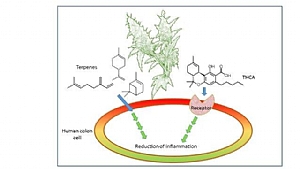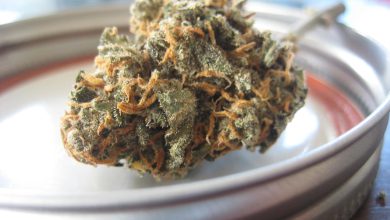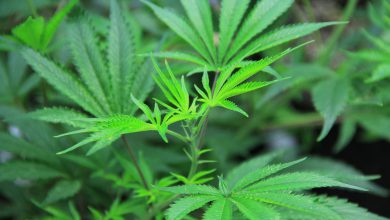The present and future of medical cannabis: specific combinations for specific medical indications
can cannabis cure diseases and not only alleviate symptoms?
Prof. Hinanit Koltai hkoltai@volcani.agri.gov.il ARO Volcani Center

marijuana, cannabis sativa, is being used by humanity for thousands of years. the interest in this plant was probably initiated mainly due to its psychotropic effects that are inferred by Δ9-tetrahydrocannabinol (thc). thc is a member of a unique group of compounds produced by cannabis, named phytocannabinoids. cannabidiol (cbd), another well-studied phytocannabinoid, is known to have anti-inflammatory effects.
however, c. sativa has the ability to produce hundreds of different compounds, including about 150 phytocannabinoids alongside a vast array of terpenes. unlike phytocannabinoids, terpenes are not unique to cannabis but produced by many other plants.
traditionally, and up to date, the relative content of thc and cbd define most cannabis ‘strains’. the cannabis ‘strains’ that are sativa-originated are “high in thc” and those that are indica-related are “high in cbd”. today, hundreds of different hybrid ‘strains’ are found, a result of repeated crossing between female and male flowers. the typical qualitatively and quantitatively profile of terpenes in each cannabis ‘strain’ contributes to the characteristic fragrance of the cannabis flower. many of these hybrids are defined based on their “aroma”, i.e., their smell and taste that derive from the specific content of terpenes.

phytocannabinoids bind to endogenous receptors in mammals distributed in different organs and cell types of the human body, and thereby exert their effects on many functions in humans, both physical and mental.
cannabis terpenes were too suggested to have some therapeutic abilities, either by themselves or as part of an entourage, acting to enhance the beneficial activity of phyto cannabinoids.
nevertheless, relying on strains and aroma and undefined entourage effect is not enough for development of cannabis–based medical treatment. for a controlled, medical grade treatment with cannabis the active compounds should be identified, and their optimal combinations and dose should be determined. we have discussed this new approach for research and drug development from medical cannabis in https://www.sciencedirect.com/science/article/pii/s0928098719300880.
in our research, we sought to specify the compounds and combinations from cannabis that have anti-inflammatory activity. in one of our studies, we focused on inflammatory bowel diseases (ibd), which include crohn’s disease (cd) and ulcerative colitis (uc). different preparations of marijuana have been shown previously to have beneficial effects for ibd patients. yet, in this research, we worked with our collaborators, physicians from the meir medical center, to identify the cannabis molecules that actually reduce colon inflammation. one of the lead molecules for reduction of inflammation was identified to be Δ9-tetrahydrocannabinolic acid (thca, figure 1).
also, the optimal combination of other compounds, that work with thca for cannabis anti-inflammatory activity were identified (figure 1). in the course of this work, we validated the activity of the cannabis-derived molecule on colon cells and colon tissues, the latter taken during colonoscopy from ibd patients (more details can be found in https://www.liebertpub.com/doi/abs/10.1089/can.2017.0027). now, in order to develop a medical use for the preferred combination, cannabis extracts enriched for these specific compounds are being formulated to allow dosage and efficient application of cannabis-based products in order to treat ibd patients. this, we believe, is a step towards proper medical use of cannabis, to alleviate efficiently and safely the symptoms associated with ibd.
figure 1: thca and other molecules (such as terpenes) from c. sativa flowers are active in reduction of inflammation in human colon cells. the molecules activity may be dependent or not on specific receptors present on the cell membrane.
these molecules trigger signal transductions in the cells that lead to reduction of colon inflammation. illustrated by omer koltai
however, a further question we asked during our studies was, can cannabis cure diseases and not only alleviate symptoms? moreover, may cannabis cure cancer? to answer these questions, at least partially, we examined the cytotoxic effect of cannabis-derived extracts on colon cancer.
colorectal cancer (crc) is the third most common cancer diagnosis and fourth leading cause of cancer-related mortality worldwide. purified single cannabinoids were shown to prevent proliferation, metastasis, and cell death in a variety of cancer cell types. however, the active compounds from cannabis flowers and their interactions remain elusive.
again, in collaboration with our colleagues, physicians from the meir medical center, we examined the effect of cannabis extracts and compounds on cancerous cell lines and on biopsies taken from polyps and tumors of the colon. we identified a whole entourage of molecule that act together to kill colon cancer cells and reduce polyp cells viability (more details can be found in https://www.liebertpub.com/doi/abs/10.1089/can.2018.0010). importantly, further experiments are needed to establish anti-cancer activity for cannabis.
yet, we hope that these findings are a step towards the future development of cannabis use for the treatment of cancer, and for the benefit of humanity.




